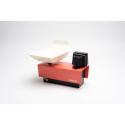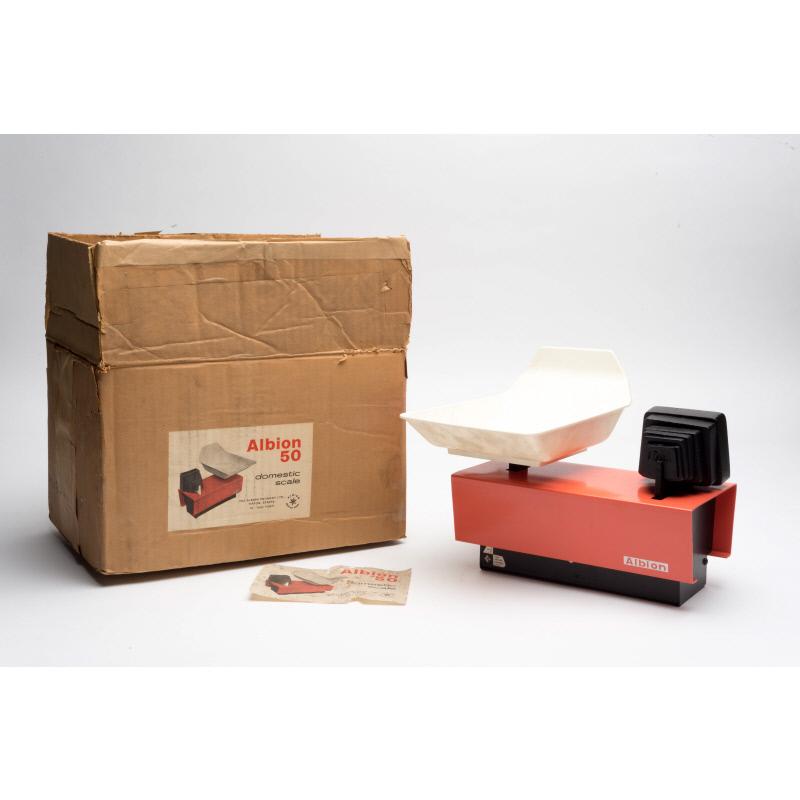Currently indexing
Weighing scale
Classification(s):
Metal
Date: c.1951 - 1976
Organisation: The Albion Foundry Ltd
Dimensions:
213 × 330 mm (21.3 × 33 cm)
Medium: Metal, plastic
Object number: M318L
Place of Production:England
Title:Albion 50
Description‘Albion 50’ weighing scale set, manufactured by The Albion Foundry Ltd, in Tipton, Staffordshire, England. The weighing scales comes with the original box and product label. The scales have a set of 7 weights ranging from 2lb to ½ oz. It has a red base and white measuring bowl.
The scales bear the label of the COID Design Centre “as selected for the Design Centre London”.
The scales bear the label of the COID Design Centre “as selected for the Design Centre London”.
ProvenanceThis object was originally acquired for the Inner London Education Authority’s (ILEA) ‘Circulating Design Scheme’ collection.
The collection was instigated by the London Country Council (later the Greater London Council) and the Council of Industrial Design (COID). The collection’s original purpose was concerned with the teaching and dissemination of modern, ‘good design’.
The collection was established in 1951/52 as the ‘Experiment in Design Appreciation’, later renamed the ‘Circulating Design Scheme’.
The Circulating Design Scheme lent boxed showcases to London schools. The showcases contained handling objects, material samples and interpretation on a specific subject.
COID withdrew its involvement in the Scheme in 1957. After which time, it was managed exclusively by the London County Council from 1957-1963.
After the administrative restructuring of London authorities, the Scheme was jointly managed by the Greater London Council and the Inner London Education Authority (ILEA) from 1963 – 1976.
The Scheme was operational until 1976 when the collections were withdrawn from circulation. ILEA was abolished in the late 1980s and the collection was donated to Camberwell College of Arts in 1989/90.
ILEA was responsible for secondary and tertiary education in the inner London boroughs, this included Camberwell.
The collection was instigated by the London Country Council (later the Greater London Council) and the Council of Industrial Design (COID). The collection’s original purpose was concerned with the teaching and dissemination of modern, ‘good design’.
The collection was established in 1951/52 as the ‘Experiment in Design Appreciation’, later renamed the ‘Circulating Design Scheme’.
The Circulating Design Scheme lent boxed showcases to London schools. The showcases contained handling objects, material samples and interpretation on a specific subject.
COID withdrew its involvement in the Scheme in 1957. After which time, it was managed exclusively by the London County Council from 1957-1963.
After the administrative restructuring of London authorities, the Scheme was jointly managed by the Greater London Council and the Inner London Education Authority (ILEA) from 1963 – 1976.
The Scheme was operational until 1976 when the collections were withdrawn from circulation. ILEA was abolished in the late 1980s and the collection was donated to Camberwell College of Arts in 1989/90.
ILEA was responsible for secondary and tertiary education in the inner London boroughs, this included Camberwell.
NotesThe Inner London Education Authority’s (I.L.E.A) Circulating Design Scheme began in 1951 in the aftermath of the Festival of Britain’s huge success. Operating in its earliest guise as the ‘Experiment in Design Appreciation’, the Circulating Design Scheme (as it was later called) was intended to form a canon of ‘good taste’. During its first 5 years of operation, the Scheme was jointly managed in a partnership between the Council of Industrial Design (C.O.I.D) and the London County Council (L.C.C). However, it can be argued that the experiment; the idea for sets of exhibits illustrating the principles of good design, can be traced further back to the Council’s own inception.
C.O.I.D had played an important role in the Festival of Britain. As early as 1947, and in preparation for the Festival, C.O.I.D had been compiling a card index of over 20,000 objects – over half of which were exhibited at the Festival. It was from this vast pool of British-made objects that the first displays for the ‘Experiment in Design Appreciation’ were collated.
In April 1956 C.O.I.D opened its Design Centre on London’s Haymarket (in the same year, C.O.I.D withdrew its involvement in the Scheme, leaving it to be managed solely by the L.C.C.). The Design Centre was a permanent public space to present displays of contemporary British design, along with a programme of special exhibitions. It became the main vehicle for communicating C.O.I.D’s ideas to the wider public. In 1957, C.O.I.D’s ‘Good Design’ awards were established to improve design standards, and to promote the best in British designs and to encourage retailers to stock them. Despite not being directly involved, C.O.I.D continued to supply the Collection through its Design Centre and especially with products that had won its ‘Good Design’ awards. Many designs represented in The Camberwell ILEA Collection were recipients of the award, evident in stickers and labels still attached to the objects; this object is one example.
C.O.I.D had played an important role in the Festival of Britain. As early as 1947, and in preparation for the Festival, C.O.I.D had been compiling a card index of over 20,000 objects – over half of which were exhibited at the Festival. It was from this vast pool of British-made objects that the first displays for the ‘Experiment in Design Appreciation’ were collated.
In April 1956 C.O.I.D opened its Design Centre on London’s Haymarket (in the same year, C.O.I.D withdrew its involvement in the Scheme, leaving it to be managed solely by the L.C.C.). The Design Centre was a permanent public space to present displays of contemporary British design, along with a programme of special exhibitions. It became the main vehicle for communicating C.O.I.D’s ideas to the wider public. In 1957, C.O.I.D’s ‘Good Design’ awards were established to improve design standards, and to promote the best in British designs and to encourage retailers to stock them. Despite not being directly involved, C.O.I.D continued to supply the Collection through its Design Centre and especially with products that had won its ‘Good Design’ awards. Many designs represented in The Camberwell ILEA Collection were recipients of the award, evident in stickers and labels still attached to the objects; this object is one example.







